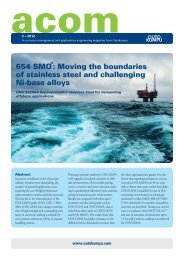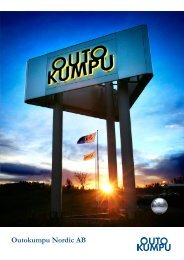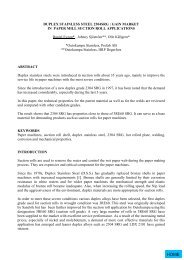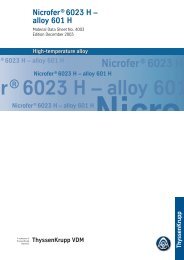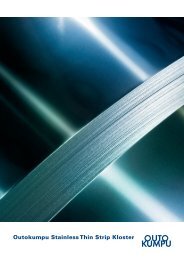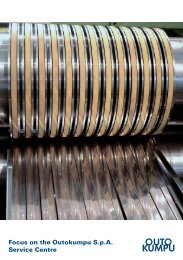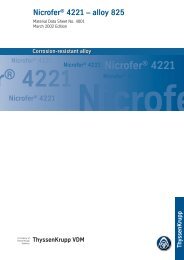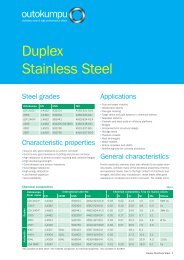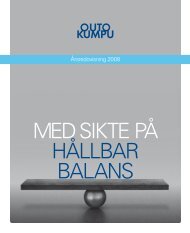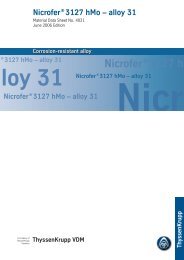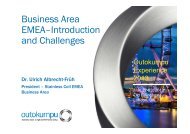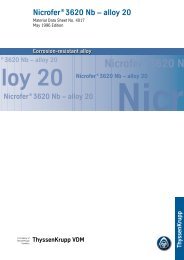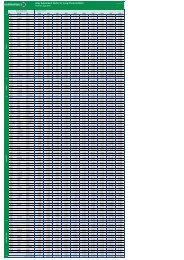Annual Report 2010 - Outokumpu
Annual Report 2010 - Outokumpu
Annual Report 2010 - Outokumpu
You also want an ePaper? Increase the reach of your titles
YUMPU automatically turns print PDFs into web optimized ePapers that Google loves.
60<br />
A long-term commitment to<br />
sustainability<br />
Stainless steel is 100% recyclable, hygienic, corrosion-resistant and the environmental impacts resulting from its use are<br />
almost non-existent. On the other hand, its production – both the manufacturing and reprocessing stages – does have an<br />
impact on the environment. The most substantial environmental impacts which result from stainless steel production<br />
process include emissions of dust and particulates into the air, discharges of water from production plants, and the high<br />
levels of direct and indirect energy consumption during production. Landfill waste is also created during the production<br />
process.<br />
<strong>Outokumpu</strong>'s way of managing environmental issues<br />
Guided by the Group's Environment, Health, Quality and Safety policies, Corporate Responsibility Policy and Ethical<br />
Principles, <strong>Outokumpu</strong>'s firm objective is to minimise the environmental burden of the Group's operations as much as<br />
this is economically and technically feasible. All <strong>Outokumpu</strong>'s larger production sites employ either Environmental<br />
Management Systems (EMS) or risk-based management systems which help in avoiding spills and accidents that could<br />
be harmful to humans or to the environment. All of these Group systems operate in accordance with ISO 14001, the<br />
international standard for environmental management systems. <strong>Outokumpu</strong>'s aim is to achieve a single Group-wide<br />
certificate. Currently 90% of our production sites have individual certification. The functioning of these systems is<br />
monitored using both internal and external audits. The Group also provides the appropriate authorities with reports on<br />
<strong>Outokumpu</strong>'s operations in all the countries in which we operate. At Group level, our operations are managed and best<br />
practices applied through our environment network, whose working groups and environment committee meet once<br />
during each quarter.<br />
<strong>Outokumpu</strong> believes that stainless steel will play an important<br />
role in the sustainable development of global infrastructure.<br />
<strong>Outokumpu</strong> to increase its focus on environmental footprint<br />
Stainless steel's very low environmental impact during the use phase, its durability and very low maintenance<br />
requirements are recognised. At the end of each product's life, its constituent materials are also fully recyclable. The life<br />
cycles of stainless steel products consist of several phases. <strong>Outokumpu</strong>'s aim is to improve levels of sustainability in<br />
each phase from production through to re-use, and also to secure a sustainable supply chain all the way from suppliers<br />
of recycled steel to the production of stainless steel products.<br />
Many applications that employ stainless steel already have a beneficial impact by reducing the total environmental<br />
burden exerted by human society. On a global scale, current trends towards achieving sustainability and reducing the<br />
extent of climate change are strong. The EU Climate and Energy Package focuses on renewable energy sources,<br />
emissions control and energy efficiency. Almost all nations and regions are targeting less-carbon-intensive forms of<br />
society.<br />
<strong>Outokumpu</strong> <strong>Annual</strong> <strong>Report</strong> <strong>2010</strong> – Business – Impact on the environment




